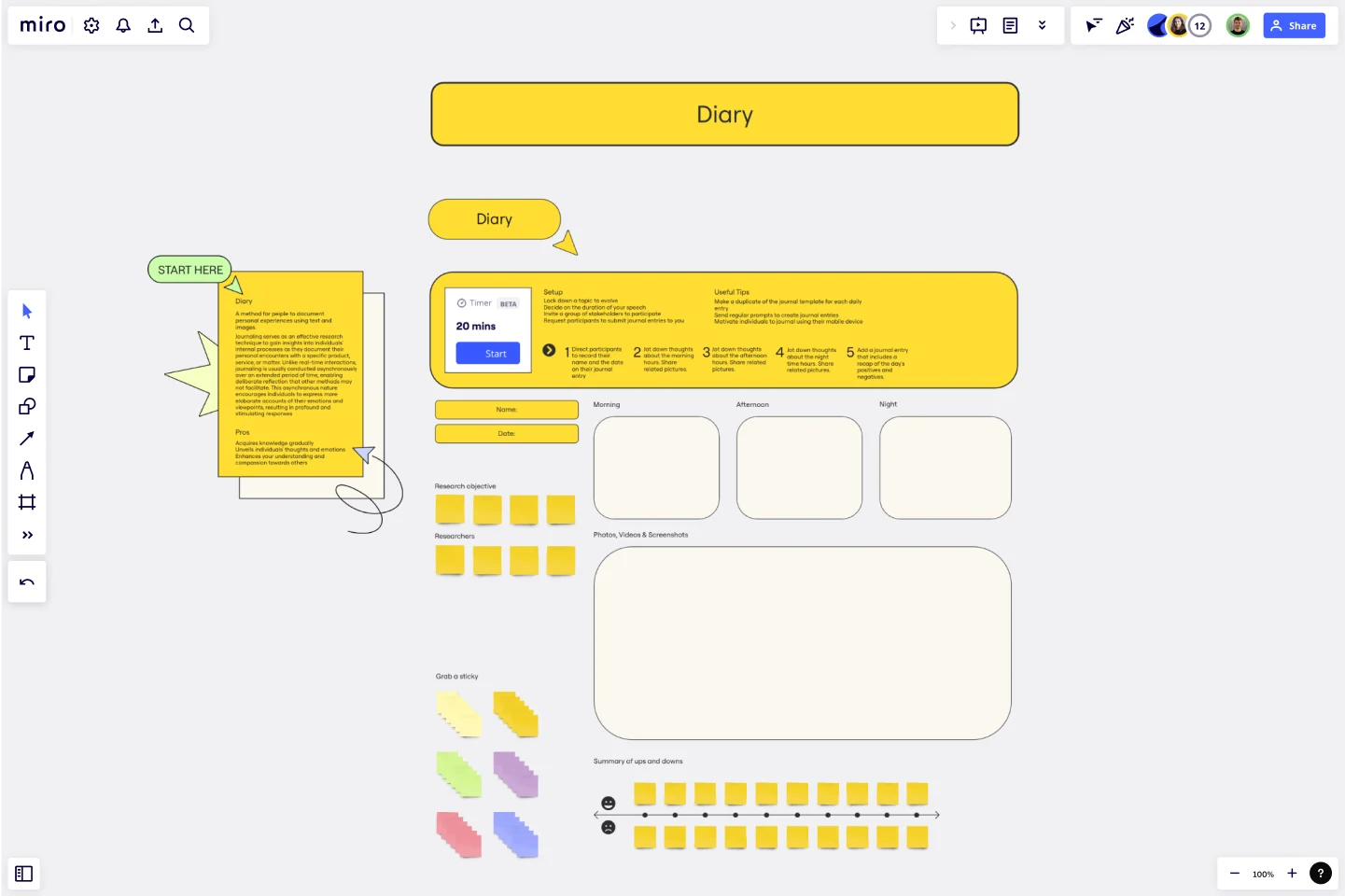Diary Template
Document personal experiences using text and images with the Diary Template.
About the Diary Template
The Diary Template is a valuable research tool for documenting experiences with a particular product, service, or subject over an extended period of time. It allows for a more thoughtful and deliberate reflection, enabling people to express emotions and viewpoints that may not have been conveyed in real-time interactions.
Journaling with the template provides a profound and in-depth understanding of people's internal processes that other research methods may not achieve. The reflective and introspective nature of journaling encourages people to share deep and insightful responses, resulting in a more comprehensive analysis of the subject being studied.
Benefits of using the template
Acquire knowledge gradually.
Unveil people's thoughts and emotions.
Enhance your understanding and compassion towards others.
How to use the template in Miro
Direct participants to record their name and the date on their journal entry
Jot down thoughts about the morning hours. Share related pictures.
Jot down thoughts about the afternoon hours. Share related pictures.
Jot down thoughts about the nighttime hours. Share related pictures.
Add a journal entry that includes a recap of the day's positives and negatives.
Setup
Lock down a topic to evolve.
Decide on the duration of your speech.
Invite a group of stakeholders to participate.
Request participants to submit journal entries to you.
Useful tips
Make a duplicate of the journal template for each daily entry.
Send regular prompts to create journal entries.
Motivate people to journal using their mobile devices.
Get started with this template right now.
The Ultimate Storyboarding Template
Works best for:
Storyboard, Design, Planning
Elevate your storyboarding with The Ultimate Storyboarding Template. Designed for ultimate flexibility and detail, this template supports a wide range of projects, from films to product launches. It includes sections for scene breakdowns, character arcs, and visual elements, making it ideal for comprehensive storytelling. Use it to create detailed, engaging storyboards that communicate your vision clearly and effectively to your team and stakeholders.
Moderated Usability Testing Template
Works best for:
Design
Encouraging individuals to express their implicit ideas helps identify the strengths and weaknesses of a design, and Moderated Usability Testing Template provides valuable perspectives. Typically, conducting only six to nine of these tests uncovers 80% of design issues, making it a cost-effective method to enhance potential solutions.
Root Cause Evaluation Template
When you first encounter a complex situation, it's not common to immediately delve into its underlying causes and effects. Often, we grasp the overall picture but fail to separate the problem from its surrounding circumstances. Root Cause Evaluation provides a method to better understand the interconnected factors that have contributed to the current situation.
User Story Map Template
Works best for:
Marketing, Desk Research, Mapping
Popularized by Jeff Patton in 2005, the user story mapping technique is an agile way to manage product backlogs. Whether you’re working alone or with a product team, you can leverage user story mapping to plan product releases. User story maps help teams stay focused on the business value and release features that customers care about. The framework helps to get a shared understanding for the cross-functional team of what needs to be done to satisfy customers' needs.
Presentation Template
Works best for:
Presentations, Education
At some point during your career, you’ll probably have to give a presentation. Presentations typically involve speaking alongside an accompanying slide deck that contains visuals, texts, and graphics to illustrate your topic. Take the stress out of presentation planning by using this presentation template to easily create effective, visually appealing slides. The presentation template can take the pressure off by helping your audience stay focused and engaged. Using simple tools, customize a slide deck, share slides with your team, get feedback, and collaborate.
Buyer Persona Template
Works best for:
Marketing, Desk Research, User Experience
You have an ideal customer: The group (or few groups) of people who will buy and love your product or service. But to reach that ideal customer, your entire team or company has to align on who that is. Buyer personas give you a simple but creative way to get that done. These semi-fictional representations of your current and potential customers can help you shape your product offering, weed out the “bad apples,” and tailor your marketing strategies for serious success.
